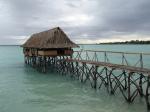Climate ‘coconut wireless’ turns 100
02 February 2016
You might not think a recurring monthly meeting would be cause for an international celebration, but you can understand our excitement when you consider:
- it’s a 12-way international call;
- with shaky phone connections at the best of times;
- involving people in five different time zones;
- with lots of ‘crackle ... crackle … beep … I think we lost the Cook Islands … are you still there Cook Islands?’; and
- plenty of long pauses, interruptions and considerable preparation time.
And every month, when it all comes together, we end up with the best and brightest climate scientists from around the region discussing crucial climate forecasts for their countries.
The Online Climate Outlook Forum is a phone hook-up between climate scientists from 12 countries around the Pacific. They spend an hour or two each month discussing and analysing what's been happening with the climate over the past month, and what to expect for the months ahead. They talk about their local rainfall predictions, discuss El Niño and La Niña, and look at what's happening with ocean temperatures. They share information about the impacts they are seeing on the ground, such as the severe water shortages that PNG is currently experiencing, and how local stakeholders are managing.
 cropped.jpg)
Samoa
The Bureau has been convening the monthly forum since 2007. In the first meeting, participants phoned in from the Cook Islands, Fiji, Samoa, Solomon Islands, Tonga, Tuvalu and Vanuatu. Since then, we have been joined by Kiribati, Niue, Papua New Guinea and the Republic of Marshall Islands. These countries range from low-lying coral atolls with populations of only a few thousand, to mountainous Papua New Guinea, with over seven million inhabitants. Each country has its own unique climate to monitor, and populations whose livelihoods rely heavily on what’s going on in the environment around them.
The 100th forum is an impressive milestone, which has only been possible with ongoing support from all the partners. So this month, all around the Pacific, meteorological services are celebrating the success of this long-term partnership with a spot of cake and tea!
When we ask the participants why this initiative has lasted so long, they tell us that it’s a simple and effective way to learn, practise, and meet other climatologists. They’ve told us that it’s useful for new climate staff—to practise putting together climate forecasts and discussing them in public. It gives them a chance to present and discuss their forecast, and get advice and suggestions on better ways to explain the complex information to their local stakeholders. Hearing from the 11 other countries, they can get the full picture of what is going on climatologically around the whole region, which helps to put their local forecast in perspective. The forum is also a good opportunity to link in to a regional network of climate scientists—people who are doing the same work hundreds and thousands of kilometres away. This is particularly useful for those who are the only climatologist in their meteorological service.
 cropped.jpg)
Niue
Further information about the Climate and Oceans Support Program in the Pacific is available at http://cosppac.bom.gov.au.


Comment. Tell us what you think of this article.
Share. Tell others.